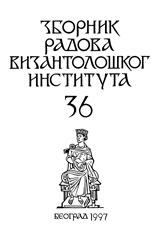Натписи историјске садржине на фрескама ХI и ХII века у западним областима Царства
Inscriptions with Historical Content in llth and 12th Century Frescoes in the Western Regions of the Empire
Author(s): Gojko Subotić, Ida TotSubject(s): History
Published by: Vizantološki institut SANU
Summary/Abstract: In Byzantium, inscriptions in frescoes acquired greater importance and richer forms after iconoclastic disputes had subsided. With few exceptions, in the European parts of the Empire texts with historical content came into being the period of the powerful rise of wan-painting in the 11th and 12th centuries. In the regions inhabited by the South SlaYs, this restoration evolved simultaneously with the spread of Christianity in their mothertongue. However, the early forms of literacy in the Serbian surroundings are insufficiently known. Therefore, it is not unusual that the texts written in wall-paintings have escaped our knowledge so far. The oldest place of worship, SS Peter and Paul's church in Ras, was the residence of the bishops subovdinated to the Archbishopric of Ohrid. It is therefore only natural to suppose that the inscriptions in it were written in Greek.
Journal: Зборник радова Византолошког института
- Issue Year: 1997
- Issue No: 36
- Page Range: 99-118
- Page Count: 20
- Language: Serbian

